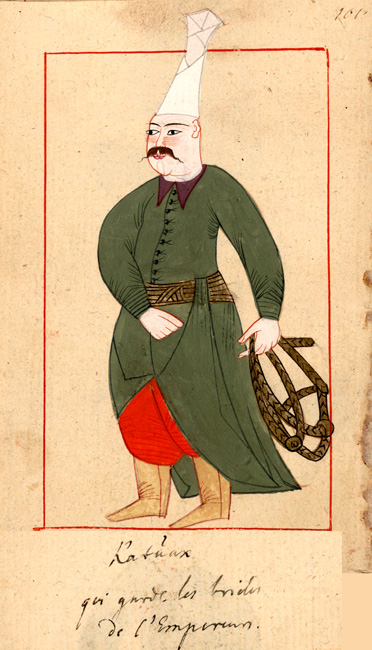Illustrations of military interest include:
Officers of the Grand Signior.
Ladle-bearer to the Janissaries.
Subaltern Officer of the janissaries.
An Officer of the Janissaries.
Two Janissaries in their dress of ceremony.
A Soldier.
An Inferior Officer of the janissaries.

A Spahi.
A Sailor.
Bostancji Bachi
A few illustrations have a more than coincidental similarity to illustrations of Ottomans circa 1790 from 'Costumes Turcs', an album previously owned by Heinrich Friedrich von Diez
There may be more but most of the items from the Diez album do not have images available from the British Museum.
Figures like these were mass produced in Ottoman workshops for sale to tourists, and the number of images desired were ususally pasted in an album with captions. They were probably copied from a master set but the artists seem to have been allowed a measure of freedom with details and colours. This can be shown by the duplicates in the Ralamb Costume Book, 1657:
 56. Greek woman |
 76. Greek woman |
 45. Sultan's groom |
 101. Sultan's groom |
 38. Khan of the Crimean Tatars |
 116. Khan of the Crimean Tatars |
There are other pairs with similar costume but with differences in the pose.
A master set can be inferred by the similarities between different albums of similar date:
Military Illustrations of Ottomans from Peter Mundy's Album, A briefe relation of the Turckes, 1618
Military Illustrations of Ottomans from Hans Sloan's Album The Habits of the Grand Signor's Court, c.1620
Illustrations of Ottomans, engraved by F.H. Clark, in McLean's The Military Costume of Turkey, 1813, are usually attributed to Octavien d'Alvimart (Written by William Miller, from whom, through John Murray, Thomas McLean purchased the rights.)
They include some figures in the same costume as in Miller's The Costume of Turkey in new poses with a background added:
Capidgi Bachi.
Ladle Bearer.
Spahi.

Spahi
Octavien d'Alvimart is not mentioned in this book, instead it says "The subjects which compose this selection, have been furnished by the liberality of a gentleman, who had stored his portfolio during his residence at Constantinople."
Could this be a clue that d'Alvimart did not paint these, but instead collected them?
Copies of figures from Miller's The Costume of Turkey plus others appeared, arranged in pairs in Illustrations de Histoire des Othomans. Moeurs, usages, costumes des Othomans, et abrégé de leur histoire / [{Artist} Non identifié] ; Antoine Laurent Castellan, Louis Mathieu Langlès, aut. du texte, 1812. There were also coloured editions e.g Kislar Aga & Sultana or Odalisk in Illustrations de Histoire des Othomans and Officers of the Grand Signior in Illustrations de Histoire des Othomans
Where more specific captions are given for some of these than in The Costume of Turkey, this is educated guesswork. The pairings in this are not evidence that the characters had anything to do with each other.
Pictures of Ottomans in the Augsburger Bilder, 1802-1810
are probably the source for some figures in McLean's The Military Costume Of Turkey:
. Ottoman Turkish Infantry
. Arab Mamalukes and Asiatic Light Infantry
. European Turkish Cavalry
. Asiatic Turkish Cavalry
Turkish Infantry after Wilhelm von Kobell, Vienna, c.1809-13
includes many figures based on Miller's Costume of Turkey.
Some of the vignettes are similar to the Augsburger Bilder including the
Artillery in the Augsburger Bilder.
Formations of uniform troops based on a single figure from Miller's Costume of Turkey are not evidence of troops wearing a uniform.
Turkish Cavalry after Wilhelm von Kobell, Vienna, c.1809-13
includes many figures based on McLean's The Military Costume Of Turkey and Miller's Costume of Turkey and one, on the far right,
is based on a Spahi after Vanmour from 100 years before.
La Turquie, ou, Costumes, Moeurs et Usages des Turcs. by Jean-Baptiste-Benoît Eyriès, 1820 Ed. with copies with added ground.
There are other books etc. that have images based on these but I'll skip forward to the 20th century -
Some appear in L'Organisation et les Uniformes de L'Armee Ottomanne by Mahmoud Chevket Pacha, 1907:

This one includes 2 figures on the right in the same pairing as in Illustrations de Histoire des Othomans: Officier inférieur des Janissaires dans son costume ordinaire, Sergent major des Janissaires. The coloured material at the front of the turban of the right-hand figure has been eliminated, perhaps because a Koulloukdji Tchaouche did not have this.
Where these figures have a more specific caption than in Miller's Costume of Turkey these are educated guesswork.
 Plate XVIII (18) Miller's The Costume of Turkey, 1802 Subaltern officer of the Janissary corps. |
 Plate XXVIII (28) Miller's The Costume of Turkey, 1802 Officer of the Janissary corps. |

p.30, Osmanli Ordu Teskilati
Mahmoud Chevket Pacha 1907 is probably the source for Osmanli Ordu Teskilati and was used by Dr Chris Flaherty. By this time they are many steps away from the originals. All these should be considered to be depicting costume of the 1790s, or if from an Ottoman album – from the last time the master set was updated before this.








